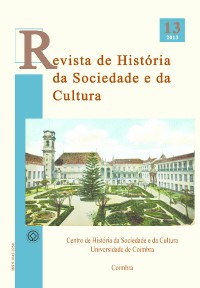Please use this identifier to cite or link to this item:
https://hdl.handle.net/10316.2/39391| DC Field | Value | Language |
|---|---|---|
| dc.contributor.author | Costa, Luís Manuel Neves | - |
| dc.date.accessioned | 2016-09-07T10:58:15Z | |
| dc.date.accessioned | 2020-09-29T20:23:22Z | - |
| dc.date.available | 2016-09-07T10:58:15Z | |
| dc.date.available | 2020-09-29T20:23:22Z | - |
| dc.date.issued | 2013 | - |
| dc.identifier.issn | 1645-2259 | - |
| dc.identifier.issn | 2183-8615 (digital) | - |
| dc.identifier.uri | https://hdl.handle.net/10316.2/39391 | - |
| dc.description.abstract | O Novo Mundo foi imaginado e interpretado com base em referenciais clássicos e medievais. O imaginário foi o primeiro elemento organizador e condutor para a apreensão e compreensão da nova realidade encontrada. A descoberta da América foi interpretada inicialmente como a descoberta da Utopia dos pensadores do séc. XVI, o novo espaço no qual seria possível localizar os projectos dos humanistas e renascentistas. O novo espaço já era povoado por homens com traços de monstruosidade, segundo as descrições dos primeiros exploradores e cronistas e as representações da iconografia da época. Entre os autores eruditos foi profundamente debatida a problemática da origem e da natureza do outro – o “índio do ocidente”. Toda a argumentação, assente fundamentalmente em bases teológicas e bíblicas, chegou a ser mobilizada tendo em vista proveitos políticos e estratégicos para a coroa espanhola. Este artigo aborda a construção e o entendimento do Outro, num entrecruzamento entre a Antropologia e a História. | por |
| dc.description.abstract | The New World was imagined and interpreted based on classical and medieval references. The imaginary was the first organizing element and the driver for the understanding and comprehension of the newly found reality. The discovery of America was initially interpreted as the discovery of the Utopia for the 16th Century thinkers, a new space where it would be possible to find renaissance and humanism projects. This new space was already inhabited by men with traits of monstrosity, according to the descriptions of the early explorers and chroniclers and the representations of the iconography of the time. Among scholars, the origin and nature of the other – the “Indian of the West” – is deeply debated. This debate, primarily based on theological and biblical bases, was mobilized in order that the Spanish crown would profit politically and strategically. This article discusses the construction and understanding of the Other, a crossing between Anthropology and History. | eng |
| dc.language.iso | por | - |
| dc.publisher | Centro de História da Sociedade e da Cultura | - |
| dc.rights | open access | - |
| dc.subject | New World | eng |
| dc.subject | America | eng |
| dc.subject | Imaginary | eng |
| dc.subject | The Other as a monstrosity | eng |
| dc.subject | Novo Mundo | por |
| dc.subject | América | por |
| dc.subject | Imaginário | por |
| dc.subject | Monstrificação do Outro | por |
| dc.title | Mundus novus, novus homo: cartografias do imaginário e do Outro no Novo Mundo (séc. XVI-XVII) | por |
| dc.type | article | - |
| uc.publication.collection | Revista de História da Sociedade e da Cultura vol. 13 | - |
| uc.publication.firstPage | 205 | - |
| uc.publication.lastPage | 229 | - |
| uc.publication.location | Coimbra | - |
| uc.publication.journalTitle | Revista de História da Sociedade e da Cultura | - |
| uc.publication.volume | 13 | por |
| dc.identifier.doi | 10.14195/1645-2259_13_9 | - |
| uc.publication.section | Artigos | - |
| uc.publication.orderno | 10 | - |
| uc.publication.area | Artes e Humanidades | - |
| uc.publication.manifest | https://dl.uc.pt/json/iiif/10316.2/39391/247575/manifest?manifest=/json/iiif/10316.2/39391/247575/manifest | - |
| uc.publication.thumbnail | https://dl.uc.pt/retrieve/11848894 | - |
| item.grantfulltext | open | - |
| item.fulltext | With Fulltext | - |
| Appears in Collections: | Revista de História da Sociedade e da Cultura | |
Files in This Item:
| File | Description | Size | Format | |
|---|---|---|---|---|
| mundus_novus__novus_homo.pdf | 2.42 MB | Adobe PDF |  |
Items in DSpace are protected by copyright, with all rights reserved, unless otherwise indicated.
